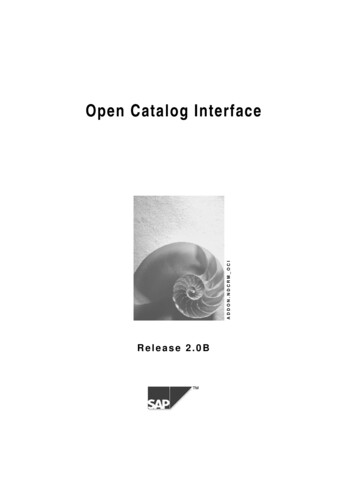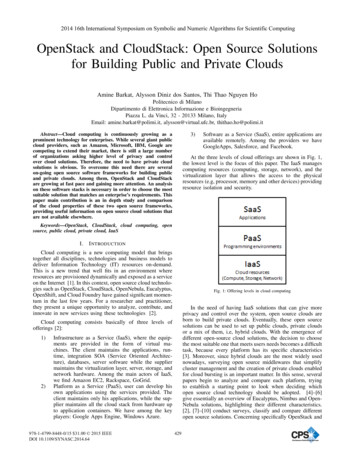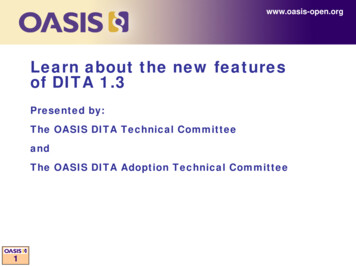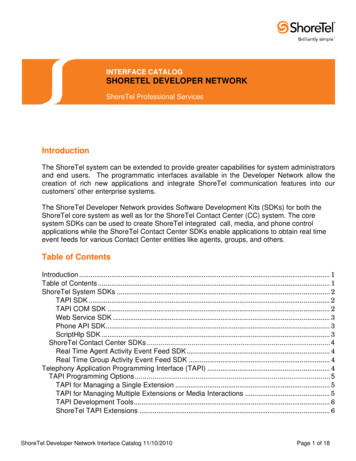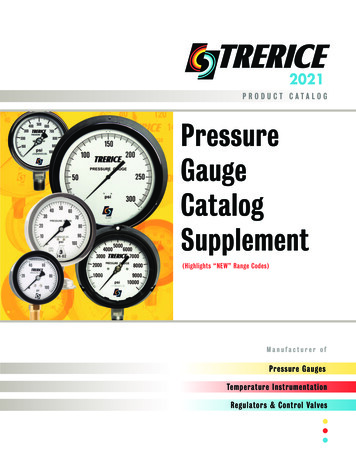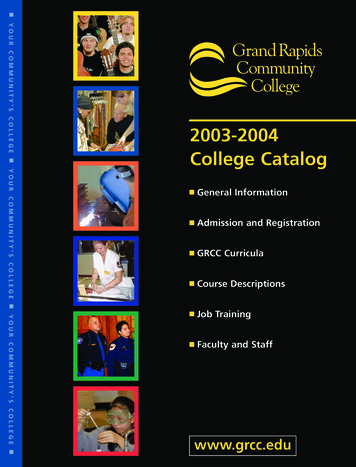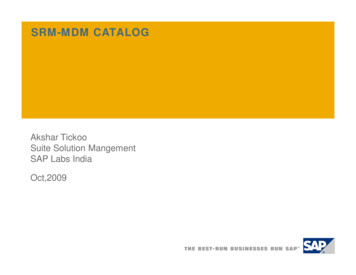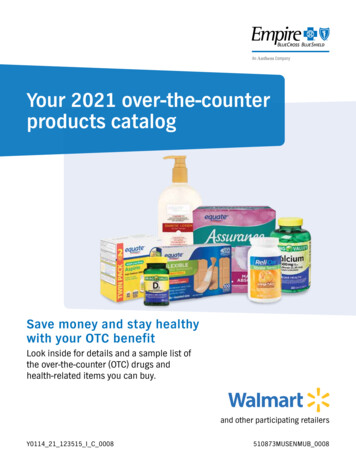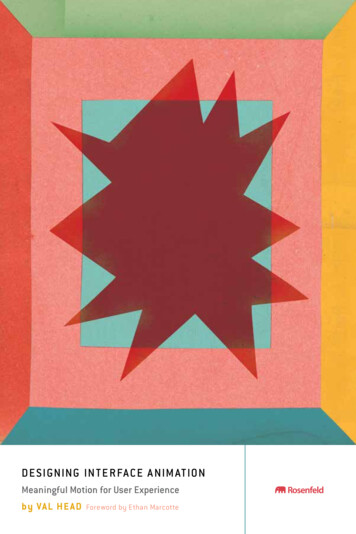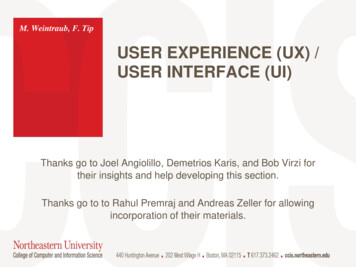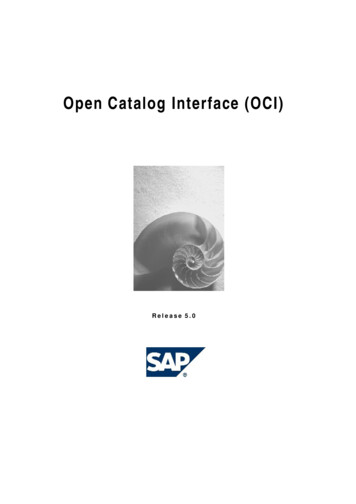
Transcription
Open Catalog Interface (OCI)Release 5.0
2003, 2013 SAP AG or an SAP affiliate company. All rights reserved.No part of this publication may be reproduced or transmitted in any form or for any purpose without theexpress permission of SAP AG. The information contained herein may be changed without prior notice.Some software products marketed by SAP AG and its distributors contain propriety softwarecomponents of other software vendors.These materials are provided by SAP AG and its affiliated companies ("SAP Group") for informationalpurposes only, without representation or warranty of any kind, and SAP Group shall not be liable forerrors or omissions with respect to the materials. The only warranties for SAP Group products andservices are those that are set forth in the express warranty statements accompanying such productsand services, if any. Nothing herein should be construed as constituting an additional warranty.SAP and other SAP products and services mentioned herein as well as their respective logos aretrademarks or registered trademarks of SAP AG in Germany and other countries. Please /index.epx#trademark for additional trademarkinformation and notes.SAP Open Catalog Interface5.02
Icons in Body taxAdditional icons are used in SAP Library documentation to help you identify different types ofinformation at a glance. For more information, see Help on HelpGeneral InformationClasses and Information Classes for Business Information Warehouse on the first page of theany version of SAP Library.Typographic ConventionsType StyleDescriptionExample textWords or characters quoted from the screen. These include fieldnames, screen titles, pushbuttons labels, menu names, menu paths,and menu options.Cross-references to other documentation.Example textEmphasized words or phrases in body text, graphic titles, and tabletitles.EXAMPLE TEXTTechnical names of system objects. These include report names,program names, transaction codes, table names, and key concepts of aprogramming language when they are surrounded by body text, forexample, SELECT and INCLUDE.Example textOutput on the screen. This includes file and directory names and theirpaths, messages, names of variables and parameters, source text, andnames of installation, upgrade and database tools.Example textExact user entry. These are words or characters that you enter in thesystem exactly as they appear in the documentation. Example text Variable user entry. Angle brackets indicate that you replace thesewords and characters with appropriate entries to make entries in thesystem.EXAMPLE TEXTKeys on the keyboard, for example, F2or ENTER.SAP Open Catalog Interface5.03
Table of Contents1Introduction .62Calling Up the Catalog Using the SRM Server . 72.1Settings in the SRM Server . 82.2URL of the Product Catalog . 82.2.1Parameters. 82.2.2Return URL .82.32.3.1Detailed Display of a Product or Service . 92.3.2Validation of a Product . 92.3.3Sourcing/Product Search . 102.3.4Background Search . 102.43Additional Functions in the Product Catalog . 9Overview of the Call-Up Parameters . 10Return from Catalog . 113.1Use of the Call-Up Parameters from Section 2.4 . 123.2Fields and Field Checks . 133.2.1Required and Optional Fields . 143.2.2Product Numbers . 143.2.3Configurable Products. 153.2.4External Product Categories. 153.2.5Introduction of New fields to enable transfer of Item Hierarchy to SRM . 153.2.6Introduction of Inbound Handler and Outbound Handler . 163.2.7Introduction of Portal Navigation while transferring data to SRM. 173.2.8Customer-Specific Extensions in the OCI . 173.3XML Variant of the OCI. 174Handling of the Browser Window . 185Secure OCI. 185.1Launching Catalog with Secure OCI . 185.1.1Initial Handshake . 195.1.2Response to backend call. 195.2Return from catalog. 205.2.15.36Initiate backend call . 20Enablement of Secure OCI for catalogs. 21Enhancements in OCI 5.0 for Mass Upload . 21SAP Open Catalog Interface5.04
6.1Mass replication of data delivered in a physical file . 226.2Mass replication of data over HTTP(s) connection . 226.3Replicating Attachments . 226.4Format for Data Transfer . 236.5Settings in the SRM Server . 236.5.1Define External Web Services. 236.5.2Activate SICF service for delivering images/attachments . 236.5.3Proxy server configuration in the BAdI SRM GET PROXY INFO . 246.5.4Customer Enhancements . 246.5.5Additional settings for Mass Upload over Http(s). 246.6Function for mass upload over Http(s) . 256.6.16.7Additional Functions. 326.7.1Catalog Managed Items . 326.7.2Technical Specification for real-time Quantity check . 336.87Technical Specification for JSON download . 25Data transfer format and rules . 336.8.2Product Numbers . 496.8.3Configurable Products. 496.8.4External Product Categories. 496.8.5Customer-Specific Extensions in the OCI . 50Troubleshooting . 50SAP Open Catalog Interface5.05
1IntroductionThe Open Catalog Interface (OCI) incorporates external product catalogs into SRM Serverapplications. This way, data that is required to create shopping cart items in the SRM Servercan be transferred directly from the external catalog to the SRM Server application.The mass upload feature is available with the release of Open Catalog Interface version 5.0,where it is possible to replicate the data from external catalogs into the SRM system usingJSON (Java Script Object Notation) format over Hyper Text Transfer Protocol (HTTP) orphysical file upload. This capability is offered only with the SAP SRM User Interface Add-On 1.0for SRM Server. The OCI 5.0 standard adds the following capabilities on top of OCI 4.0:a. Catalog data replication to SRM so that the end users can search for items in all catalogsusing SAP Enterprise Search without leaving the SAP SRM screen. Catalog serviceproviders can choose which items are replicated to SAP SRM and to what extent. Detailsare provided in section 6.b. Introduction of new fields to enable transfer of item hierarchy to SAP SRM. Details areprovided in section 3.2.5.c. Introduction of the inbound and the outbound handler. Details are provided in section3.2.6.d. Secure transfer of user credentials (Secure OCI). Details are provided in section 5.For a catalog to be OCI 5.0 compliant, it must also be OCI 4.0 compliant and support thefeatures listed above.SRM Server continues to adhere to the OCI version 4.0 and below, which offers the transfermechanisms over Hyper Text Transfer Protocol (HTTP).Figure 1 Overview of Open Catalog Interface 4.0In this case, the user is working with an SRM Server application, which displays the availablecatalogs. The user calls up one of these, selects the required products, and then transfers theproduct data back to the SRM Server application.This documentation describes both the architecture and the structure of the OCI and thusSAP Open Catalog Interface5.06
provides all the information that is necessary to support the OCI with a product catalog. Inaddition, it describes the possible processes and their prerequisites. The documentation hasbeen written both for producers of catalogs and for system administrators of SRM Serversystems.Section 2 describes how the SRM Server calls the catalog as specified in OCI 4.0.Section 3 describes how the data is transferred from the catalog to the SRM Server asspecified in OCI 4.0.Section 4 describes the handling of the different browser windows specified in OCI 4.0.Section 5 describes the additions made to Secure OCI.Section 6 describes enhancements that have been made for OCI 5.0.2Calling Up the Catalog Using the SRM ServerIn order for a product catalog to be called up using the intranet or internet, its URL must beknown in the SRM Server. If the product catalog requires additional parameters for the call-up(for example, logon names or a language identifier), these parameters also have to be knownin the SRM Server before the call-up.Figure 2 Calling the Web ServiceThe URL and the catalog parameters are defined in the Customizing for SAP SupplierRelationship Management under Master DataDefine External Web Services (Catalogs,Vendor Lists etc.). In the technical settings, you can set GET or POST as the HTTP methodfor the call-up, the standard value is POST. The user’s browser then calls up the catalogusing the URL and the parameters.Depending on the situation, other parameters besides those defined in Customizing for SAPSupplier Relationship Management can also be transferred to the catalog on call-up. Thesemight be, for example, to provide the catalog with generic data or to activate specific functionsin the catalog.Section 2.4 describes a summary of the transferred parameters.SAP Open Catalog Interface5.07
2.1 Settings in the SRM ServerIn the SRM Server, you must enter the URL and parameters of the catalog in the followingorder in the Customizing for Supplier Relationship Management: SRM ServerMasterDataDefine External Web Services (Catalogs, Vendor Lists etc.).2.2 URL of the Product CatalogYou enter the URL of the catalog in the first line of the call structure; all subsequent entries(including the return URL in line 4) are transferred to the catalog as parameters. You do notneed to specify a parameter name for the URL itself. URL is used here as the type. If the URLis longer than the field, you can distribute the URL over several successive fields that are thenall of the type, URL. You cannot enter Parameters as part of the URL; maintain themseparately as described in the following section.2.2.1 ParametersFollowing the URL, you must specify all parameters that the catalog requires on call-up. Theprovider of the catalog must have documented the names and valid values of theseparameters.The parameter type can be either Fixed Value or SAP Field. This parameter type determineshow the value of the parameter is determined from the Content column. In the case ofparameter type, fixed values, the system enters the value of the parameter directly in theContent column. In the case of parameters of type, SAP Field (generic parameters), the nameof a SAP System variable exists. For the value of the parameter, the content of this systemvariable at runtime is used. This way it is possible, for example, to transfer the systemlanguage as a parameter, you choose the parameter type as SAP Field and sy-langu ascontent. In this manner, you can transfer all the globally available fields at runtime from theSRM Server as parameters.Transfer of additional parametersIf the fixed values and the generic parameter values are not sufficient for the chosen process,you can implement the Business Add-In (BAdI), Transfer Additional Parameters(BBP CAT CALL ENRICH) to transfer additional parameters from the SRM Server system tothe catalog. Using this BAdI, you can determine and transfer multiple name-value pairs, tocome up when you call a catalog. In addition, if you want to change the format of genericparameters, you can use this BAdI to convert these parameters. For example, you can use thisBAdI to convert the system language to a different format: DE- de instead of simply DE.As of SAP SRM 2.0, a sample implementation is available for the BAdI Transfer AdditionalParameters (BBP CAT CALL ENRICH), which reads the relevant user data in the SRMServer and transfers it to the catalog (however, the sample implementation is only run if thebusiness type of the category is set to E-form).As an example of how this data can be used by the catalog, see the ASP page (ASP ActiveServer Pages) that is stored in the SRM Server System in the Internet ServiceBBP FREEFORM in the file freeform.zip. When you open all the data in an executabledirectory on an ASP-compatible Web server, you can use this page as a catalog application forordering business cards. All the form fields automatically have the default values that havepreviously been transferred by the BAdI implementation. The user only needs to check theaccuracy of the entries.This ASP page can, of course, only serve as a template. The example is intended to show theoptions that are available on a project basis with a catalog and the implementation of the BAdITransfer Additional Parameters (BBP CAT CALL ENRICH).2.2.2 Return URLThe return URL is required so that the data from the catalog can be transferred back to theSRM Server application via the user’s browser. The catalog must place it in the Actionattribute of the transfer form. The return URL is also transferred to the catalog as aparameter. It usually contains other parameters (see below) that must first be extracted andplaced in separate input fields (of type hidden) of the form.SAP Open Catalog Interface5.08
All parameters after the return URL are generated as parameters for the return URL; they arenot transferred to the catalog as individual parameters. You can name the parameter for thereturn URL as you wish since the parameter must be evaluated by the catalog (usuallyHOOK URL is used as the parameter name). The value of the return URL must be empty; theactual return URL is determined during run time.As of SRM Server 4.0, the specification of the return URL and the following parameters isoptional in Customizing. If they are not specified, the return URL including the parameters isgenerated automatically. In this case HOOK URL is used as the name for the return URL. Thename of the return URL must be specified only if the catalog expects a different name for thereturn URL than HOOK URL. Even if the name has been specified for the return URL, as ofSRM Server 4.0 the parameters for the return URL need no longer be specified; they are alsogenerated automatically in this case.2.3 Additional Functions in the Product CatalogThe product catalog can provide additional functions that can be used by SRM Serverapplications. In order to trigger these functions, additional parameters (defined within OCI) aretransferred to the catalog when it is called up. If the product catalog supports one or more ofthe following functions, this is to be stated in the product catalog documentation. This isbecause an appropriate flag must be set in SRM Server Customizing so that the relevantSRM Server application can make use of the functionality. The fact that the interface supportsthe additional functionality does not necessarily mean that the functionality is actually used bya SRM Server application.Currently the following functionality is supported by the OCI:2.3.1 Detailed Display of a Product or ServiceA product that has already been transferred to a SRM Server document using the OCI is to bedisplayed again later in the catalog. This serves to display detail data directly in the catalogthat may not be defined in the OCI and that is also not available in the SRM Server.In order to activate the function, the following parameters are transferred to the product catalogon call-up:NameValueFUNCTIONDETAILPRODUCTID Database key for the product in the catalog Then the product catalog should immediately display the detail view of the correspondingproduct. With this function no data is transferred from the product catalog to the SRM Server.A prerequisite for this function is that before the first time this product is transferred from theproduct catalog to the SRM Server System, the field NEW ITEM- EXT PRODUCT ID isfilled with the database key of the product in the catalog. In addition, in Customizing for SAPSupplier Relationship Management under SRM Server - Master Data - Define ExternalWeb Services (Catalogs, Vendor Lists etc.) for the corresponding catalog, the DisplayProduct Data Again in Catalog checkbox must be selected.2.3.2 Validation of a ProductIf an item from a product catalog has been added to a template for an SAP SRM documentthen it is possible, for example, that the price of the product has changed over time. If a newSAP SRM document were to be created from this template, the price change would usuallynot be taken into account. The function serves to update the product information in thetemplate while the SAP SRM document is being created.In order to activate the function, the
The Open Catalog Interface (OCI) incorporates external product catalogs into SRM Server applications. This way, data that is required to create shopping cart items in the SRM Server can be transferred directly from the external catalog to the SRM Server application. The mass upload feature is available with the release of Open Catalog Interface .
